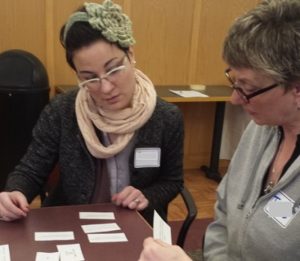- MN ABE Connect
- Archive
- Learn about Pronunciation! Easy and Fun Activities
 January 16, 2018
January 16, 2018
Learn about Pronunciation! Easy and Fun Activities
Andrea Echelberger, MN Literacy Council / ATLAS Study Circle FacilitatorHave you ever learned a word or a phrase in a new language, then tried it out on a native speaker, only to have them look at you blankly? As teachers of adult EL learners, we want to make sure that our learners are able to speak intelligible English to the native English speakers that they need to communicate with outside of the classroom. The best way to make sure that learners can speak intelligibly in to incorporate pronunciation into our classroom curriculum and lesson plans on a regular basis.
But where to begin? Below are two pronunciation activities that are a great starting point for teachers new to teaching pronunciation, as well as information about the upcoming Pronunciation Study Circle offered by ATLAS.
Word Stress Activities
In English, any word with more than two syllables contains a syllable that is stressed. Word stress, when it is misplaced or lacking, is a major cause of pronunciation misunderstandings. Many EL learners come from language backgrounds that do not have word stress or that use different stress patterns. This can make it difficult for learners to pick up on word stress patterns unless they are specifically taught to listen for and replicate the patterns when they speak. These two activities that can be used with any vocabulary or reading lesson to incorporate word stress into your English instruction.
Activity 1: Show the Word Stress
This activity builds listening awareness of word stress, and allows the teacher to check learners’ understanding visually. The visual and kinesthetic aspects of the activity help learners remember the stress patterns.
Materials Needed: counters (such as pennies or bingo chips)
- Say a word from the weekly unit.
- Have the learners lay out one counter for each syllable. If the word has three syllables, the learners should lay out three counters.
- Repeat the word. Have the learners move up the counter that represents the stressed syllable in the word. You may need to repeat the word several times, and you made need to emphasize the stressed syllable if learners are struggling with hearing the stress in the word.
- Have the learners repeat the word, tapping the counters as they say each word out loud. Listen to make sure that they stress the correct syllable.

Expansion: Have learners in the group take turns reading the words. The rest of the group will show the stress pattern that they hear. The learner who reads the words can also be responsible for checking to see that everyone in the group shows the correct pattern.
Activity 2: Word Stress Chart
This activity helps learners visually identify word stress patterns in new vocabulary, and helps them to focus on the most critical words in a message.
Materials Needed: reading text, Word Stress Charts
- Ask the learners read through their text and identify the 10 words that they think are the most critical to the meaning of the text. Learners may go through the text as a group, go through the text and select words individually, then discuss their choices in the small group to come to a consensus, or go through the text individually and each select their own words.
- Have the learners write their words down in the Word columns of the Word Stress Charts.
- Read the text out loud. Have the learners listen for the stress patterns in the words that they identified, and draw circles to represent the word stress pattern in the Stress Pattern columns for each word, one circle for each syllable. The circles for the unstressed syllables will be small, and the circle for the stressed syllable will be large. You may need to repeat this step several times.
- Have the learners read their lists of words aloud. Check for the correct word stress patterns.
- Give the learners a few minutes to practice the pronunciation of their selected words individually or with a partner.
- Have learners read the text out loud. Check that they are using the correct word stress patterns on the selected words from their chart.

Expansion 1: Have learners write 10 words from the weekly unit on the Word Stress Chart. After working together to fill in the stress patterns on the chart, let the learners practice saying the words. Give the learners a few minutes to think of a story that uses as many words from the chart as possible. Have the learners take turns telling their stories aloud, focusing on using the correct word stress from the words on the chart.
Expansion 2: Ask the learners to tell you a story. At the end of the story, work together to identify the most important words, and fill in the Word Stress Chart. Let the learners practice the words, then have them retell the story, focusing on using the correct word stress from the selected words on their chart.
Learn how to teach pronunciation
 If you would like to begin to teach word stress as well as other powerful pronunciation features to your EL learners, but aren’t sure of where to start, you’re not alone! ATLAS has created the Pronunciation Study Circle in order for adult EL teachers to develop the teaching practices that are needed to successfully teach pronunciation in your classroom.
If you would like to begin to teach word stress as well as other powerful pronunciation features to your EL learners, but aren’t sure of where to start, you’re not alone! ATLAS has created the Pronunciation Study Circle in order for adult EL teachers to develop the teaching practices that are needed to successfully teach pronunciation in your classroom.
How do study circles work?
Study circles are small learning groups of practitioners who meet to discuss issues of relevance to their classroom practice, incorporating relevant research as well as written or classroom-based reflection tasks. Participants have the opportunity to access support and ideas among colleagues who teach similar levels, thereby creating more effective, engaging, and satisfying teaching and learning experiences in their classrooms.
Upcoming Pronunciation Study Circle Opportunities
ATLAS is excited to announce that the Pronunciation Study Circle will be offered in the winter of 2018! The face-to-face meetings will be held from 1:30-4:30 pm on February 16, March 2, and March 16 at Hamline University. If you are interested in participating in the study circle, please register at the ATLAS website. Participants will receive a $75 stipend and a free book upon completion of the study circle. Space is limited to 12 participants, so sign up quickly!
Newsletter Signup
Get MN ABE Connect—the official source for ABE events, activities, and resources!
Sign UpArticle Categories
- ABE Foundations/Staff Onboarding
- ACES/Transitions
- Adult Career Pathways
- Assessment
- CCR Standards
- Citizenship
- COVID-19
- Cultural Competency
- Digital Literacy/Northstar
- Disabilities
- Distance Learning/Education
- ELA
- Equity/Inclusion
- ESL
- HSE/Adult Diploma
- Listening
- Math/Numeracy
- Mental Health
- Minnesota ABE
- One-Room Schoolhouse/Multilevel
- Professional Development
- Program Management
- Reading
- Remote Instruction
- Science
- Social Studies
- Speaking/Conversation
- Support Services
- Teaching Strategies
- Technology
- Uncategorized
- Volunteers/Tutors
- Writing